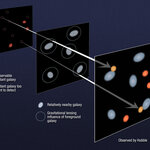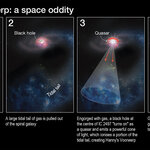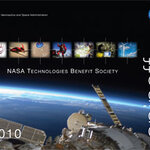Space

Wanna go to Mars? It's a one-way trip, and over 500 people have volunteered already.
The Journal of Cosomology-- yes, them again-- became the accidental sign-up agency for us ordinary folk who are willing to take that one-way trip to our neighboring planet.
In October of 2010, the Journal of Cosmology received an unexpected and surprising email. A 70-year old man was volunteering for a one-way mission to Mars. Emails from over a dozen hopeful volunteers were received the next day from men of all ages, and the pattern continued until November when a flood of mails were received, over 80…

When I was a younger guy, I read my astrology sign 'predictions' in the newspaper. It was in the comics section, so clearly no one took it too seriously. But astrology had at least a foundation in science. Unfortunately, like homeopathy, it has long outlived its quirky time even though it has been shown to be rubbish.
But people who do have an interest in astrology will want to take notice soon. Astronomer Parke Kunkle told NBC the astrology signs have not been updated in so long they aren't really accurate. In fact, there need to be 13 instead of 12, due to…
Little green men. Can they exist? Do they exist? And what do they look like?
Published this week in Philosophical Transactions A is an extravaganza of papers about extraterrestrial life, and what we should do when we meet them. As for the first two questions, the answers are, to paraphrase from the papers: yes, they could exist, and; we just don’t know yet whether they do. But the third question, tackled by Simon Conway Morris in the journal, is most intriguing, and one that has been thought about ever since we knew that the Earth wasn’t the only planet. We are finally at the stage of knowing…
Observations done at the W. M. Keck Observatory on Hawaii's Mauna Kea have found 16 close-knit pairs of supermassive black holes in merging galaxies.
These black-hole pairs, also called binaries, are about a hundred to a thousand times closer together than most that have been observed before, providing astronomers a glimpse into how these behemoths and their host galaxies merge—a crucial part of understanding the evolution of the universe. Although few similarly close pairs have been seen previously, this is the largest population of such objects observed as the result of a systematic search…

A new paper says that as many as 20 percent of the most distant galaxies currently detected appear brighter than they actually are, because of an effect called "strong gravitational lensing."
How strong gravitational lensing works; from our view on Earth, if a faraway galaxy and a nearby galaxy line up on the sky, the gravity of the nearby galaxy bends the light from the faraway galaxy, as if the nearer galaxy were a magnifying glass, or lens. Einstein predicted decades ago that gravity could bend light, and astronomers have since proven him right. In fact, modern astronomers exploit…

Hanny's Voorwerp, a strange, glowing green cloud of gas that has mystified astronomers since its discovery in 2007, has gotten a better look by Hubble. The cloud of gas is lit up by the bright light of a nearby quasar and shows signs of ongoing star formation.
Hanny's Voorwerp (Hanny's Object in Dutch) is a mysterious, glowing green blob of gas is floating in space near a spiral galaxy - the size of the Milky Way.Hanny's Voorwerp (Hanny's Object in Dutch) is named after Hanny van Arkel, the Dutch schoolteacher who discovered the ghostly structure in 2007 while participating in the online…
It all started back in the olden-days of mid-2007 with GalaxyZoo: the ultimate in online, interactive citizen science where anyone with eyes, an Internet connection, patience, and an appreciation for beautiful galactic images from the Sloan Digital Sky Survey could make a reasonably important contribution to astrophysical scientific research. Driven by the initial success of this project, including an in-press research paper featuring the discovery of an ionisation nebula coined "Hanny's Voorwerp" from a GalaxyZoo user, the supporting researchers of GalaxyZoo and the Citizen Science Alliance…

Given all the NASA funding, you think we'd get something from it! Oh, wait, we do. SpaceRef pointed me to the NASA SpinOff 2010 report. What did we get for our $19 billion annual NASA budget? I mean, that's a lot of money, that's... oh, wait, that's not a lot of money today. My mistake. True, you could buy 19 Stealth Bombers for that cost. Or fight a typical war for 1 month. But could you... save the airlines $2 billion in fuel costs with NASA wing mods? Make a sensor that's in 1 in 3 cell phones? Turns out we do get some bang for…

As we noted a few times this month, a lunar eclipse is happening soon and while lunar eclipses occur twice a year, this is the first time on the Winter Solstice since 1554 A.D. The second most popular question we get about lunar eclipses (First being "Is it safe to look at? Answer: "Yes") involves the reddish color - people want to know why the moon looks red during a lunar eclipse.
First, the basics: A lunar eclipse happens when the moon, Earth, and the sun all line up with Earth in the middle. It is an eclipse because Earth's shadow is cast onto the full…

Where can one see the lunar eclipse online or at a viewing party. Here are a couple of options and how to find out.
The best option would be to watch the eclipse online via NASA's live feed of the eclipse from Huntsville Alabama. Which I have embedded right here.
A good option would be to go to a local planetarium or university. Where their will almost certainly be dedicated sky watchers who will set up the live feed and make a party out of the event. The Adler Planetarium in Chicago is going to have such an event tonight If as the forecast…